Every computer that’s connected to the internet has an Internet Protocol (IP) address. However, not all IP addresses look or behave the same way.
Understanding the difference between dynamic and static IPs is vital if you’re working with computer networks or servers. By learning more about each protocol, you can choose the most appropriate solution for your needs.
In this article, we’ll discuss the difference between static vs dynamic IPs. We’ll also help you figure out your IP address and explain how to assign it a fixed number (if that’s what you prefer).
Let’s get to work!
An Introduction to Static IP and Dynamic IP Addresses
As we mentioned before, every internet-enabled device has an IP address. It can be a unique numeric or alphanumeric string of characters, depending on which protocol you use. Most devices use IPv4 addresses, which look similar to this: 151.164.152.92.
Although IP addresses may appear random at first, they include a lot of information about your current network. Here’s what each segment in the above example represents:
- 151.164.xx.xx — This first half of the IP address identifies your network. It can refer to an internet provider or even a broader set of devices, depending on your location.
- xx.xx.152.92 — The second half of the IP address identifies your host and each machine in your network. Not all devices on your local network will share the same IP address.
Keep in mind that this is just one example of an IP address. When we talk about “static” addresses, we’re referring to a series of numbers that identify your device and never change.
If you have a dynamic IP address, the numeric identifier will change periodically. Usually, this adjustment is made by your internet service provider (ISP), often without you even realizing it (since it usually doesn’t affect the browsing experience).
Determining What Your IP Is
Finding your IP address works differently depending on which operating system (OS) you’re using. Let’s go over the process for both Windows and macOS devices.
How to Find Your IP Address in Windows
The easiest way to find your IP address in Windows is to open the start menu, type “cmd” and launch the command prompt. Once the command prompt opens, type “ipconfig /all” and hit the Enter key.
The command prompt will return information about all of your network adapters, so you’ll need to identify which one you’re using:

That’s a lot of information to sort through, but there are only two elements that are important right now:
- IPv4 Address: This is your IP address, and in this case, we’re using the IPv4 protocol.
- DHCP Enabled: If the Dynamic Host Configuration Protocol (DHCP) is enabled, it means you don’t have a static IP address.
We’ll discuss the advantages and disadvantages of dynamic vs static IPs in a moment. For now, let’s go over how to find your IP address if you’re using macOS.
How to Find Your IP Address in macOS
If you’re using macOS, the quickest way to find your IP address is to open the Network Preferences menu and select the network you’re using. Click on the relevant Advanced button, and then select the TCP/IP tab:

Your IP address will show up next to either the IPv4 Address or IPv6 Address, depending on which protocol your network uses. We’ll talk about the difference between these protocols in a later section. For now, check to see if the Using DHCP option is enabled under either section.
If DHCP is enabled, you have a dynamic IP address. You already know the difference between dynamic and static IP addresses, but now it’s time to talk about which option you should be using.
Static vs Dynamic IP Addresses (4 Key Considerations)
There are pros and cons to using either static or dynamic IP addresses. In the following sections, we’ll break down four significant considerations to keep in mind when choosing these types.
1. When You Should Use a Static IP Address
The two kinds of devices most often assigned static IPs are servers and peripherals. If you’re using your device to browse the web, then it technically doesn’t matter if your IP address changes all the time.
However, static IP addresses are a necessity in some situations, including:
- Connecting to Virtual Private Networks (VPNs) with allowlisted IP addresses
- Accessing website admin sections with allowlisted IP addresses
- Accessing your devices remotely
Many web hosts and email providers offer static IP addresses as extras or perks on specific plans. However, you don’t necessarily need a static IP address for running a website.
If you work remotely and you need to connect to a VPN to access work files, the chances are that your employer will ask you to set up a static IP address. Allowlisting IP addresses enables employers and other network administrators to decide who has access to the system, which is critical for security purposes.
Having a static IP address in either of those scenarios also means you’re the only person using it. With a shared IP address, you might get penalized if another user sends spam or sets up a website that’s deemed unsafe.
However, in practice, any reputable web host or email provider will ensure that you don’t run into any problems, even if you’re using a shared IP. At Kinsta, for example, we use a range of shared IP addresses provided by Cloudflare, and your website won’t suffer any downsides from it.
2. When You Should Use a Dynamic IP Address
In most cases, it doesn’t matter if your IP address changes regularly. If you don’t have to access private networks often or no one needs remote access to your device, you can do without a static IP address.
It’s important to note that there are a finite number of IP addresses — even if they change dynamically, some IP addresses end up repeating or getting shared. In the past, shared IP addresses posed severe concerns for websites and personal use. However, these days there are almost no downsides to not having a static IP address.
3. Static vs Dynamic IP Addresses for Home Networks: Which One to Use
Your internet provider will determine whether you use a dynamic or a static IP address in most cases. However, there are always workarounds to set up a static IP address, even if your provider offers dynamic IPs by default.
If you need to connect to a VPN or a website with an allowlist of IP addresses, you will need a static IP. However, if you only require access to your home network devices remotely, most modern tools enable you to connect to them without inputting IP addresses.
Google Chrome Remote Desktop, for example, asks you for a unique access code instead of an IP address:
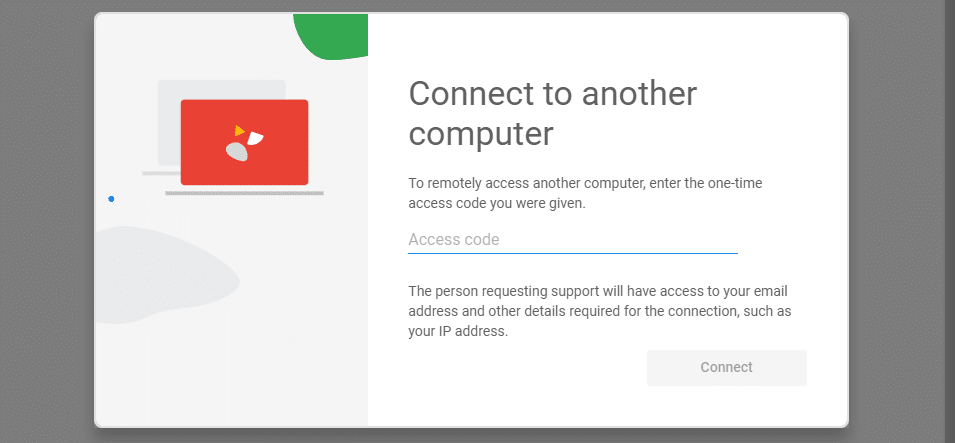
The availability of such tools means that you’ll rarely need a static IP address versus a dynamic one for your home network.
4. Dynamic IP vs Static IP: Safety Considerations
If someone knows your server or personal device’s IP address, they can try to connect to it. Even if your home devices or servers don’t contain any precious information, malicious actors might try to break in. If you have a static IP address, that means those hackers always know where to reach you.
Dynamic IP addresses are the safer option out of the box. However, it’s important to note that even if attackers know where to find you, that doesn’t necessarily mean they will get in. With proper security measures, a static IP address can be just as safe a choice as a dynamic one.
The Difference Between IPv4 and IPv6 Addresses
So far, we’ve only focused on IPv4 addresses. However, that’s not the only protocol available. IPv6 is another option, which at some point will likely become the norm for IP addresses.
There are several differences between these protocols. The primary reason the world is slowly transitioning to IPv6 is that IPv4 can only support around four billion IP addresses due to how it’s configured.
Since it’s becoming all too common for people to have multiple internet-enabled devices, four billion IP addresses are not enough, even with the help of DHCP. The IPv6 protocol solves that problem by using alphanumeric addresses, in contrast to IPv4’s numbers-only approach.
Here’s an example of what an IPv6 address looks like:
2001:0db8:0000:0000:0000:ff00:0042:7879
The increased length and the mix of letters and numbers mean that the IPv6 address can support 340 trillion addresses. With such a vast number, we shouldn’t run out for a very long time.
Right now, only about 35% of all devices in the world are using IPv6 addresses. Like IPv4, the IPv6 protocol supports both static and dynamic addresses. That means all of the considerations we’ve talked about so far also apply to this newer protocol.
How to Get a Static IP Address
If you need a static IP address, there are several ways you can get one, depending on what your situation is. In this section, we’ll cover all of them, whether you want to set or change a static IP for a web server or a local network device (wired or wireless).
How to Set a Static IP for a Web or Email Server
If you want to set up a static (non-shared) IP for a web or email server that you don’t host yourself, you’ll need to ask your provider for one. In many cases, web hosting or email providers will offer static IPs as extras if you’re using a VPS or a cloud hosting plan.
Keep in mind that paying for a dedicated server doesn’t necessarily mean you’ll get a static IP. Dynamic IPs are the norm in most cases, so you may still need to pay for an extra one even if you sign up for a dedicated plan.
How to Assign a Static IP Address to a Local Device
Many people recommend contacting your internet provider if you have a dynamic IP address and want a static one. However, in our experience, most internet providers cannot assign static IP addresses to residential customers.
Your best option is to configure a static IP yourself through your OS or router if that includes you. If you need a static IP to connect to another network with an allowlisted address, you can also use a VPN that offers fixed addresses.
How to Assign a Static IP to Windows Devices
As you might recall, IPv4 addresses include both network and host identifiers. In most cases, you can configure your devices to use static IPs without fear of conflict with other addresses.
If you’re using Windows, you can do this by accessing the Network & Internet section under your OS settings, and then selecting Change adapter options:
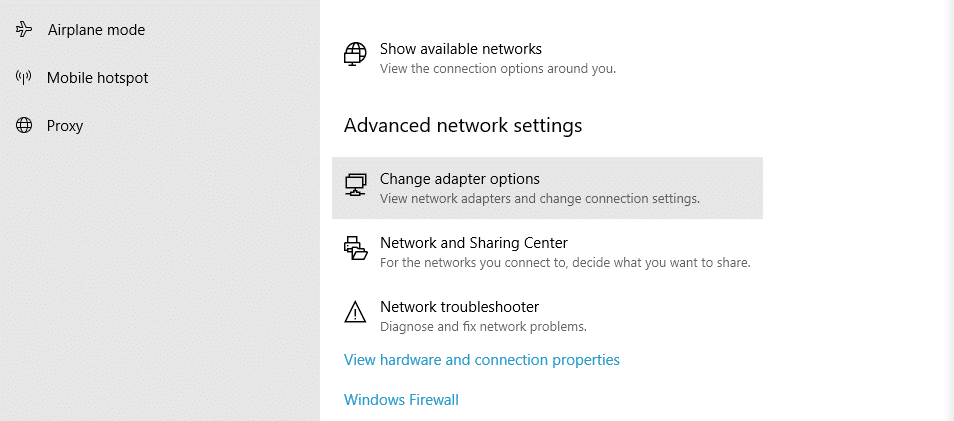
You’ll see an overview of all of your available network connections. Right-click on your active network connection and select Properties. Next, click on the Internet Protocol Version 4 (TCP/IPv4) option in the window that pops up, followed by the Properties button:
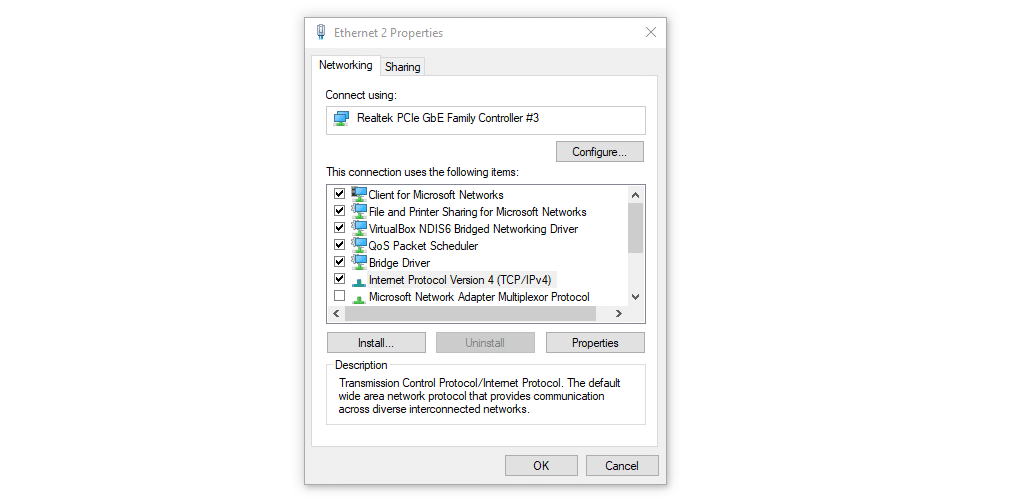
A new window will open, enabling you to select the Use the following IP address setting. Click on that option, and then set the static IP address you want to use:
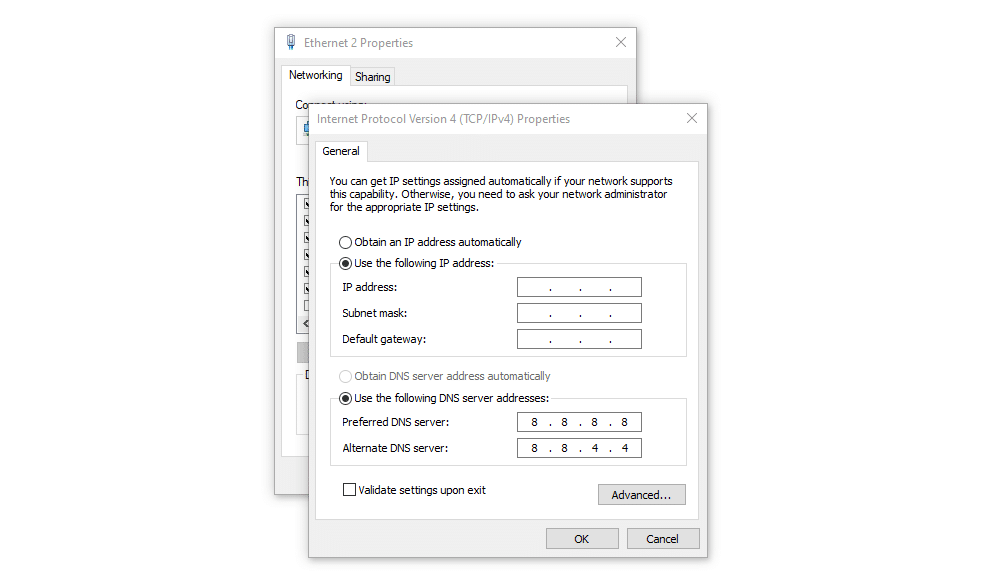
Keep in mind that you can’t just enter any values that you want. Here’s some guidance for filling out each field so that you won’t run into any errors:
- IP address: The static IP you set should copy the first three segments of your current address. If your address right now is “XXX.XXX.XXX.XXX”, the new one should be “XXX.XXX.XXX.YYY”. That’s because those first segments identify both your network and your host.
- Subnet mask: If you’re using a residential network, your subnet mask should be “255.255.255.0”, which means your network uses 24 bits for its identifier.
- Default gateway: This should be your router’s IP address, which you can find by opening the command prompt and typing “ipconfig /all.”
Once you fill out every field, click on OK. If your settings are correct, you’ll have a new static IP.
How to Assign a Static IP to macOS Devices
Assigning a static IP address on a macOS device works in a very similar way. You also have to enter an IP address, a subnet mask, and your default gateway (which you can read about in the previous section).
The only difference is that getting to those settings requires a different route. Here are the three steps to access the Configure IPv4 menu for your active network in macOS:
- Open the Apple menu, click on System Preferences, and then select the Network option.
- Click on Ethernet in the left-hand panel.
- Select the Manually option under the Configure IPv4 menu settings.
Once you complete those steps, you’ll need to fill out the following fields, including your new static IP address, subnet mask, and default gateway:
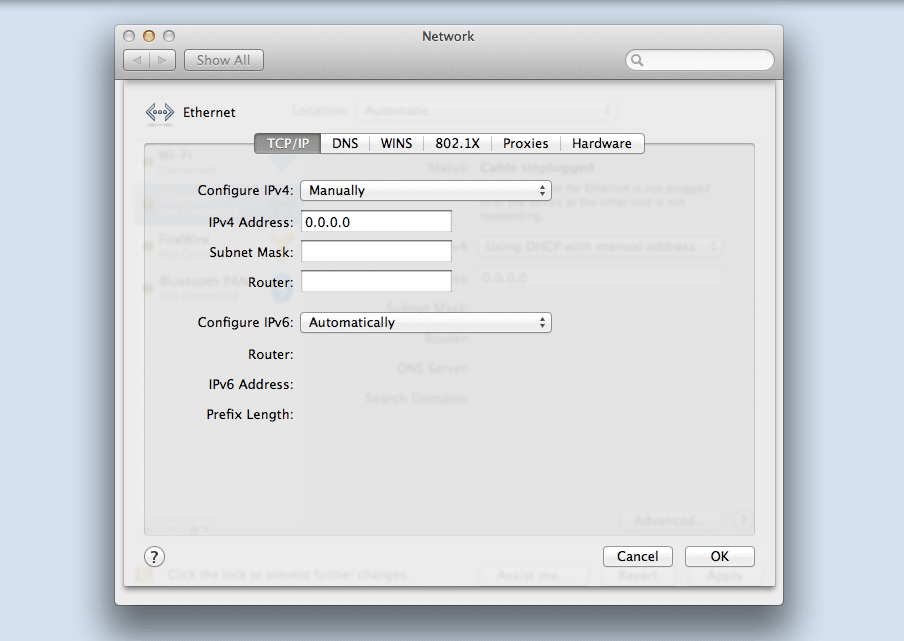
Save the changes to your network configuration, and you’re good to go. Now your IP address will remain static as long as you don’t revert the changes to your network.
Summary
Most internet and web hosting providers will assign you dynamic IP addresses. Typically, that’s not a bad thing. However, there are some situations where having a static IP is necessary, such as if you need to access a work VPN with allowlisted addresses.
If you’re running a website, however, you probably don’t need a static IP. At Kinsta, we offer shared IP addresses provided by Cloudflare to all our customers. Even without a dedicated IP, most of our customers see significant improvements in their sites’ performance.
Host your Static site for free with Kinsta’s Static site hosting and deploy your website directly to the edge.
Do you have any questions about static vs dynamic IP addresses? Let us know in the comments section below!



Leave a Reply